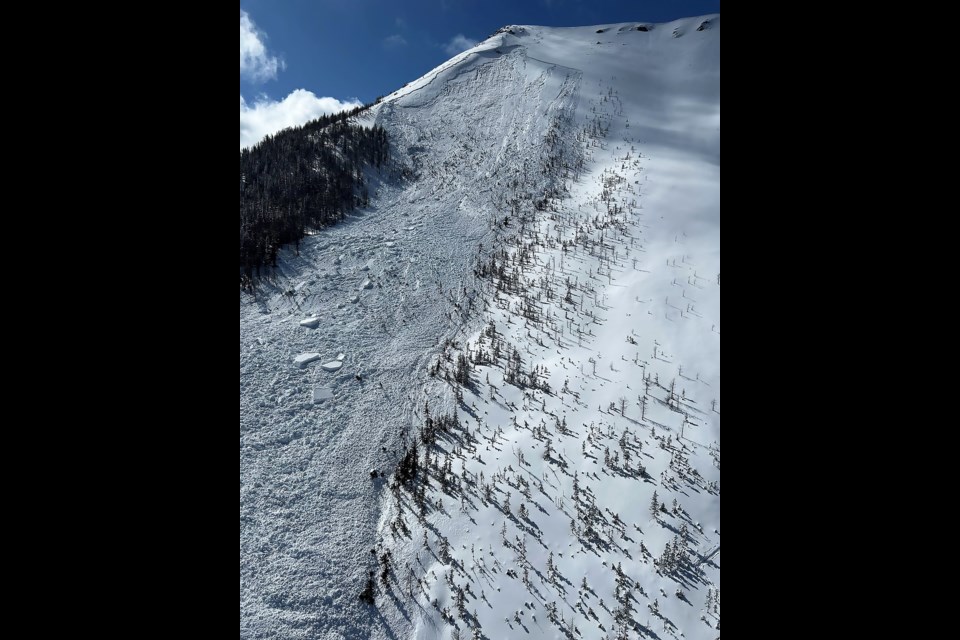KANANASKIS COUNTRY – Rescuers are calling an avalanche that partially buried a skier on Tent Ridge in Kananaskis Country on the weekend an “extremely close call.”
According to a report posted to Avalanche Canada’s Mountain Information Network (MIN), there were two people in the group, but only one was carried “all the way to near the bottom of the [avalanche] path and was partially buried,” also losing their skis and poles.
Jeremy Mackenzie, a mountain rescue specialist with Kananaskis Mountain Rescue, said the skier caught in the avalanche Sunday (March 24) was very lucky to escape without injury, or worse.
“Not only were they lucky to only be partially buried, but they did travel a significant distance down the slope through some sparse forest and they could have easily struck a tree and had a different outcome. So, it was an extremely close call,” he said, noting it was also an “aggressive ski line.”
“It’s a type of terrain feature that normally you would want to give significant, lengthy periods of stable snow before you would consider skiing it.”
Avalanche Canada’s forecast summary for Sunday noted the avalanche was triggered after the involved skier’s fourth turn on a line down the mountain, resulting in the person being carried down and buried up to their neck in snow.
The slide occurred on the northwest aspect of the mountain at 2,400 metres elevation, just below the summit of Tent Bowl around 12 p.m.
“The avalanche depth varied from thin to thick, with evidence of the March 20 interface, the Feb. 3 crust, the basal facets and the ground. Some of the blocks were the size of a Ferrari,” noted the forecast summary prepared by Kananaskis Mountain Rescue.
On Sunday, Avalanche Canada’s forecast in Kananaskis had the avalanche risk rated as moderate at alpine and treeline, meaning natural avalanches were unlikely but human-triggered slides were possible. The risk was rated low below treeline.
Mackenzie said a line such as the one the skiers attempted down Tent Ridge is one that should only be attempted after days or weeks of low avalanche hazard, rather than at moderate or higher hazard levels.
He said Kananaskis Mountain Rescue observed several bold or aggressive lines skied across the region over the weekend and advised outdoor recreationists to make more cautious decisions in avalanche terrain at this time of year.
“This year’s snowpack and this time of year is not quite yet the time to be looking at doing those sorts of things.”
The snowpack this winter is complex, Mackenzie noted, and has several buried crusts that have proven difficult to evaluate for avalanche forecasters and have potential to cause large sliding layers.
“We just don’t think it’s a good time to be looking at some of the bigger terrain features like that,” he said.
Kananaskis Mountain Rescue was not called to respond to the avalanche on Tent Ridge on Sunday but was notified of the slide by a conservation officer who observed it while travelling along Highway 40.
The rescue agency then met with the skiers to check if there were injuries and ask about the incident. Mackenzie said the skiers were equipped with necessary avalanche safety gear, including a probe, transceiver and shovel.
As of Wednesday (March 27), Avalanche Canada’s forecast in Kananaskis had the avalanche risk rated as moderate at alpine and treeline. The risk was rated low below treeline.
A snowpack summary issued Sunday said this past weekend left the region with 20-30 centimetres of snow.
“Recent winds have created some wind slabs in the alpine. … When the sun comes out and the temperature rises, the avalanche hazard will increase.”
Risk of avalanche in Banff National Park was rated moderate at alpine and low at and below treeline Wednesday.
In Yoho and Kootenay national parks, the risk was rated low at all elevations as of Wednesday, according to the Avalanche Canada forecast.
There have been two fatal avalanches in Kananaskis Country this past winter, with the first – a size 2 avalanche – fully burying an ice climber and partially burying another on Nov. 11, 2023, in the Ranger Creek area in Peter Lougheed Provincial Park. The fully buried person was killed.
The second fatality occurred March 10 on Tower Peak, during a special avalanche warning for all of western Canada. The size 3 avalanche swept two skiers between 150-250 metres down slope, fully burying the person who was killed and burying the other up to the top of his head.
Despite the partially buried person being able to dig himself out and locate his friend via transceiver, the fully buried skier did not survive.
The Local Journalism Initiative is funded by the Government of Canada. The position covers Îyârhe (Stoney) Nakoda First Nation and Kananaskis Country.



